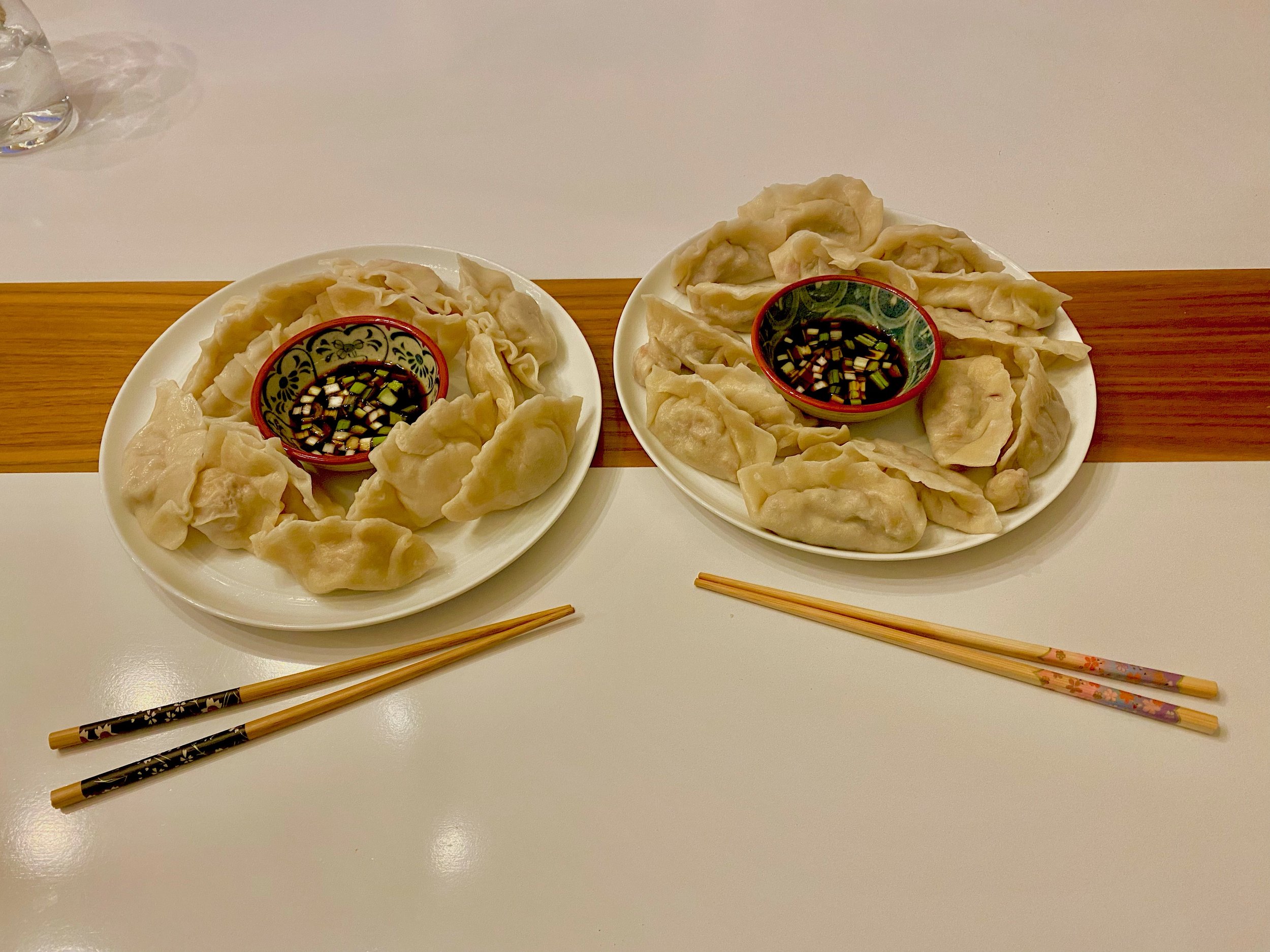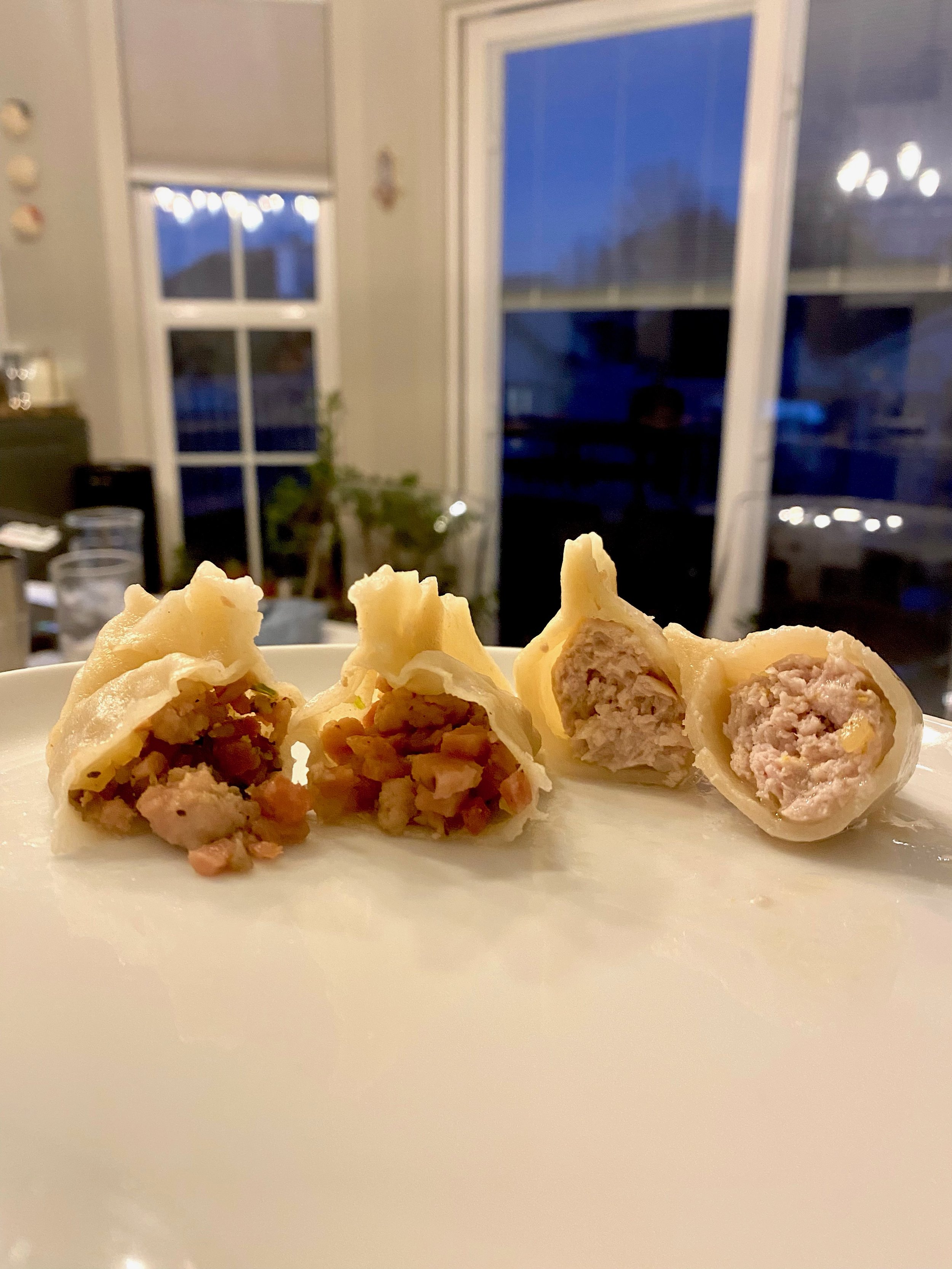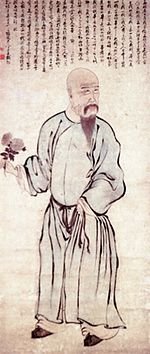Hu Sihui and Yuan Mei’s Dumplings
Project Overview
Dumplings are represented in many cultures throughout the world and remain a hallmark of Chinese cuisine today. Their invention is often attributed to Zhang Zhongjing, a Chinese physician and writer of the Eastern Han Dynasty. He is known for his many foundational contributions to traditional Chinese medicine practices. For this project, I initially wanted to make his original recipe but had much difficulty verifying it. So instead, I recreated two other historical dumpling recipes—one from A Soup for the Qan: Chinese Dietary Medicine of the Mongol Era, As Seen in Hu Sihui’s Yinshan Zhengyao (written during the Yuan dynasty), and a second from Recipes From the Garden of Contentment: Yuan Mei’s Manual of Gastronomy (written during the Qing dynasty). These cookbooks were selected from different time periods in order to compare how dumpling recipes evolved over time.
There are many other translated versions of Yinshan Zhengyao, and this reproduction was based on a fragmented Yuan dynasty original copy. Hu Sihui wrote Yinshan Zhengyao when he served as court nutritionist for the Mongol-led Yuan empire, so the cookbook serves as a nutritional guide for dietary beliefs of the time. It also reflects many international flavors, which were likely included as a deliberate attempt to reflect the empire’s broad reach [2]. Translators for Yinshan Zhengyao note that pork recipes are virtually nonexistent in the text, likely because they were such “everyday fare” that Hu didn’t think it necessary to include them. Sheep is paramount in this cookbook, with nearly all of the recipes involving some part of the sheep [2]. One parallel between the dumpling recipes in Yinshan Zhengyao and Zhang Zhongjing’s original recipe is that they both called for mutton, or sheep. Below is a video that shows the process for making Zhang’s original recipe [3].
Yuan Mei originally published The Way of Eating in 1792, roughly the middle of the Qing period. Yuan Mei was a prolific painter and writer most famous for his poetry. The Way of Eating includes both recipes and Yuan’s views on cooking, which departed from the extravagant displays typical of many cooks at the time. Instead, Yuan promoted simpler, traditional ways of cooking. He believed “each ingredient has its own unique character and cannot be mixed without confusing its flavor… These days we see flamboyant chefs boiling chickens, ducks, pigs and geese together in soup, producing dishes with tastes indistinguishable from, and as flavorful as, chewing on wax” [6]. The recipe I decided to make from Yuan Mei called for pork, a departure from the sheep called for in Hu Sihui’s recipe. According to Frederick J. Simoons in Food in China: A Cultural and Historical Inquiry, this choice of pork was characteristic of the times. In a survey from 1929-1933 (just 17 years after the end of the Qing dynasty), pork and lard provided over 70% of total human intake of animal calories in China as a whole [1]. Pork is also characterized as ‘neutral’ or ‘cold’ in the medicinal hot-cold classification and is often cooked with ‘hot’ ingredients like ginger or pepper, which is reflected in the recipe from Yuan Mei that I chose. In addition to the jiaozi recipe from Yuan Mei, I also made one of his braised pork recipes as filling for the dumplings.
Portrait of Yuan Mei painted by Luo Ping [5]
The Recipes
Below are the original recipes from each cookbook as they appeared in the translated texts.
This is the original dumpling recipe from Hu Sihui:
Shilön Horns
Mutton, sheep’s fat, sheep’s tail, onions, prepared mandarin orange peel, sprouting ginger. (Cut each up finely).
[To] ingredients add spices, salt and sauce and mix [everything] together uniformly. Take white flour, honey and vegetable oil and mix together. Put into boiling water in a cauldron. When cooked make skins [2].
These are the original dumpling and braised-pork recipes from Yuan Mei:
Dianbuleng (meat Jiaozi)
Flatten pieces of dough, fill them with pork, then steam them. Making these well is completely dependent on how the filling is prepared. Quite simply, the pork has to be tender, with any tendons removed, and then seasoned well. I’ve been to Guangdong and at the dianbuleng of Garrison Commander Guan, which were excellent. The filling was made from pork skin that had been braised into a soft paste, which provided a soft and wondrous texture [6].
Pork Braised with Ham
Cut the dry-cured ham into square pieces and boil them, starting from cold water three times in total, and then drain them dry. Cut the pork into square pieces, then boil them starting from cold water twice and drain them dry. Braise the prepared ham and pork together in water. To finish the dish, add to it four lian of jiu, green onions, Sichuan pepper, bamboo shoots, and shiitake mushrooms [6].
To make the cooking process easier for myself to follow I translated the above original recipes into a more modern, cookbook-friendly format. As I discuss later, I modified aspects of the original recipes to account for the ingredients I had access to.
Hu’s Mutton (Lamb) Dumpling Recipe
Ingredients
Filling
Lamb/mutton
Onions
Zested mandarin orange peel
Minced ginger
Salt
Dough
2 cups all-purpose flour
Honey
Vegetable oil
Recipe Steps
In a large bowl, combine ground lamb with diced onions, orange zest, minced ginger, and salt. Set aside to work on the dough.
For the dough, add flour, honey and vegetable oil together. Boil until cooked.
Roll the dough into long cylinders and cut about 1.5 inch segments
Roll these out with your palm into roughly 3-inch diameter circles
Fill the circles with a spoonful of the lamb filling and then fold the tops.
Ladle them into boiling water, making sure to not put too many in at a time so that they don’t bump into one another.
Remove and let them cool on a plate before serving with soy sauce or black vinegar topped with spring onions.
Yuan Mei’s Pork Dumpling Recipe
Ingredients
Filling
Pork
Dry-cured ham
Green onions
Sichuan pepper
Bamboo shoots
Shiitake mushrooms
Rice wine
Water
Soy sauce
Salt
Vinegar
Dough
2 cups all-purpose flour
⅔ cup of boiling water
Tapioca flour for rolling out the dough
Tools/Supplies
2 pots (one for braising meat, another for boiling the dumplings)
Rolling pin
Knives
Cutting boards
Recipe Steps
Make the dumpling wrapper dough. Use chopsticks to combine 2 cups of flour with about 2/3 cup of water. Knead until combined and cover bowl with a towel for about 1 hour. Make the filling as the dough rises.
Cut the cured ham into squares and boil the pieces. Repeat three times, starting with cold water each time.
Boil the pork and drain it to dry.
Braise the pork and ham together in water.
While the pork is cooking, make the dough for the dumpling wrappers and set the dough aside to let it until it bounces back when pressed (this means that the gluten has developed).
Finely chop the green onions, bamboo shoots, and shiitake mushrooms.
Grind the Sichuan peppercorns and add the sifted spice to the fillings in step 5.
Add diced ingredients, the Sichuan pepper, and rice wine to the braised meat and let simmer.
While the meat cooks, roll the dough into long cylinders and cut about 1.5 inch segments.
Roll these out with your palm into roughly 3-inch diameter circles
Place a spoonful of the filling in each wrapper and fold. You can use water on the edges to help seal them.
Ladle them into boiling water, making sure to not put too many in at a time so that they don’t bump into one another.
Remove and let them cool on a plate before serving with soy sauce or black vinegar topped with spring onions.
Process Photos
A Note on the Dumpling Wrappers
I referred to the below video for a technique on rolling out the dumpling dough and achieving the small, circular wrappers. Neither cookbook included any reference for how to make the dumpling wrappers. I assume this is because they only use water and flour, which both writers would have assumed their readers already knew how to make. I looked for a technique like the one in this video because it shows how to make the wrappers from just a rolling pin without relying on something to cut out the round shape, which I thought was likely more authentic [4].
Scroll through to see the dumpling wrapper process —>
Reflections & Discussion
I made adjustments for both recipes due to ingredient constraints. For Hu Sihui’s dumpling recipe, I originally wanted to use ground lamb as a substitute for mutton. The store I went to was out of ground lamb, so I used ground pork instead. Pork and lamb have similar fat contents so I figured they would cook similarly. Pork was also a commonly used meat during the Yuan Dynasty and was perhaps left out of the cookbook because it was so common, a suggestion from the book’s translators.
The other modification I made to Hu’s recipe was for the dumpling dough. His recipe called for flour, vegetable oil, and honey which would then be boiled until cooked. I tried this and failed miserably. It turned into a soggy mess when I tried to boil it, and when I baked it to try and salvage the ingredients for some kind of crust, it just crumbled into a moist flour in the mouth when eaten. It was truly one of the most bizarre food textures I've ever experienced. For the wrappers, the dough I made for the other recipe ended up being enough for both recipes so I used that instead. Ultimately, since the most substantial change I made to the recipe was the change of meat, and the meat I used was also common practice at the time, my experiment was as grounded as possible in the texts and resources available. If I were to make this recipe again, the simplest modification I would make is increasing the amount of ginger and salt I included in the filling. I would also try and figure out how to make the dumpling wrappers using vegetable oil-based dough. I think adding an egg or some sort of other binder may help, but ultimately I would want to conduct more research into historical dough making practices to understand common ingredients and techniques.
The Failed Dough Experiment
For Yuan Mei’s recipe, the cut of pork was not specified so I also used ground pork. His jiaozi recipe called for a pork that was very tender, and ground pork already lacks tendons and other parts of the meat that would make it tougher to chew, so I think this was a suitable substitution. Since I used ground pork, I couldn’t cut the pork into square pieces for boiling, so I just added the ground pork to the cured ham after it had been boiled. These were braised together in water, as the original recipe called for.
The braised pork recipe I made was not originally intended to be used as a dumpling filling, so I also modified it by chopping the cured ham into very small pieces and by dicing the other ingredients finely. I don’t believe this detracts too much from the authenticity of the flavors, though, since the chopping changes mostly affect the dish’s presentation.
In the translation of Yuan Mei’s book, the translators include ‘A Note on Jiu’ [6]. In short, there is no satisfactory, existing translation for jiu. Traditional Chinese jiu has a unique fermentation process that makes it incomparable to other sorts of beverages for which there are English translations. Jiu is generally translated into English as ‘rice wine’ or ‘Chinese liquor,’ so I used rice wine in my recipe. Because I can’t verify if the rice wine I used was made with traditional Chinese practices, it is possible that this is a source of historical inaccuracy.
If I were to recreate Yuan Mei’s recipe again, I would use a pork tenderloin since it is more appropriate for braising than ground pork. All in all, though, I think my recreation of Yuan Mei’s recipe is also grounded in the historical texts and resources available. Yuan especially emphasized simpler ways of cooking, and I was able to adhere to relatively few ingredients, kitchen tools, and different techniques to produce his recipe.
The Final Products



Works Cited
[1] Cunha, Mary B., and Frederick J. Simoons. 1991. Food in China: A Cultural and Historical Inquiry. Edited by Frederick J. Simoons. N.p.: CRC-Press.
[2] Husihui, A Soup for the Qan: Chinese Dietary Medicine of the Mongol era as Seen in Hu Szu-hui's Yin-shan cheng-yao: Introduction, Translation, Commentary, and Chinese text, translated by Paul D. Buell and Eugene N. Anderson, with appendix by Charles Perry (Oxon; New York : Routledge, 2016).
[3] The History Channel. 2021. “The Original Chinese Dumpling Had a Unique Purpose | Ancient Recipes with Sohla.” YouTube. https://www.youtube.com/watch?v=EcqqhQqemxU.
[4] The Omnivore's Cookbook. 2015. “How to Make Chinese Dumplings (recipe) 饺子.” YouTube. https://www.youtube.com/watch?v=J6xFRlG5Qxg.
[5] Ping, Luo. n.d. “Yuan Mei.” Wikipedia. Accessed November 28, 2021. https://en.wikipedia.org/wiki/Yuan_Mei.
[6] Yuan Mei, Recipes from the Garden of Contentment: Yuan Mei's Manual of Gastronomy (English and Chinese Edition).


















